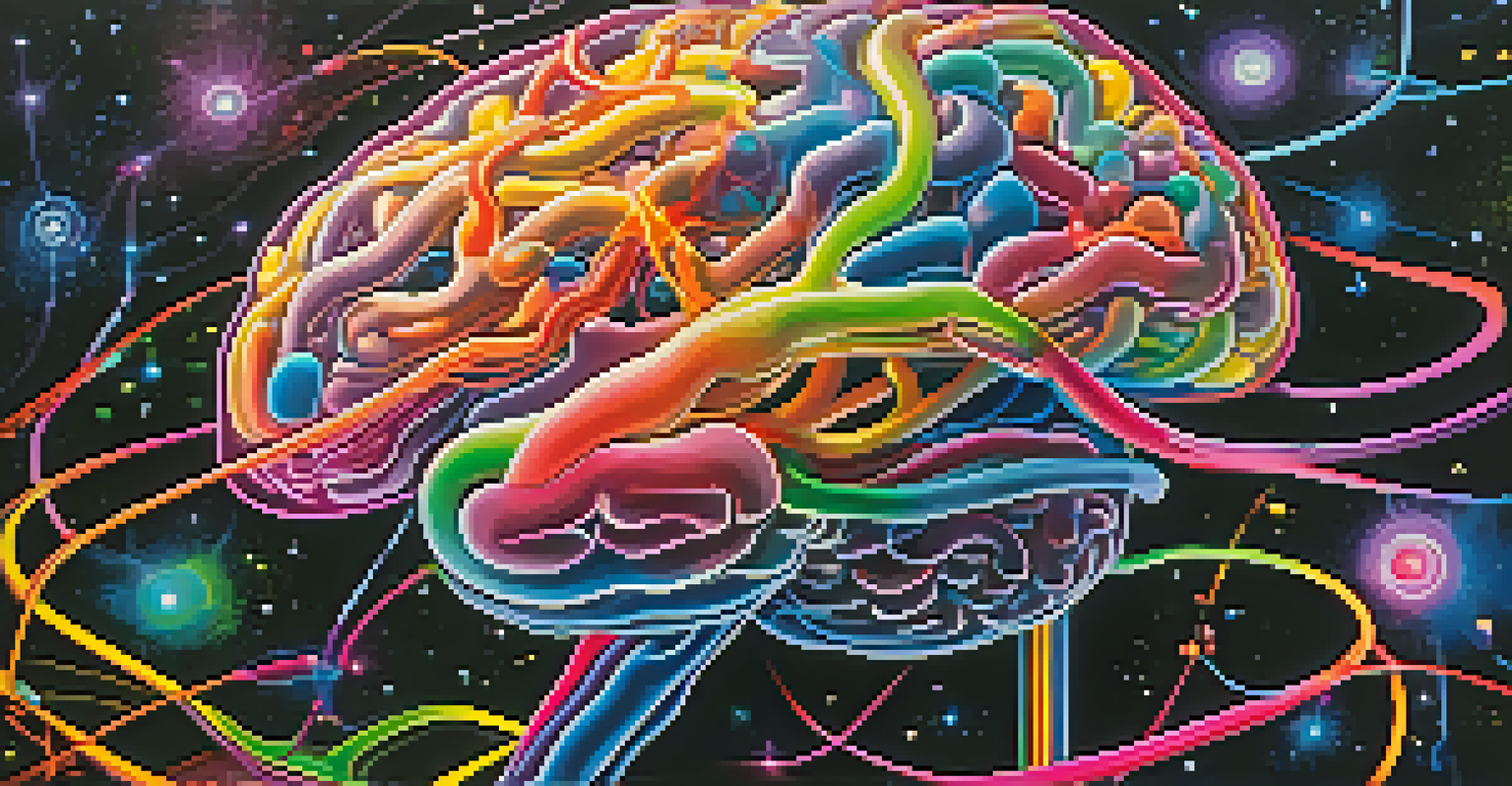The Pharmacology of Mescaline: How It Affects the Brain

Understanding Mescaline: A Brief Overview
Mescaline is a naturally occurring psychedelic compound found in various cacti, most notably the peyote cactus. This fascinating substance has been used for centuries in indigenous rituals, often for spiritual and healing purposes. Its chemical structure closely resembles serotonin, which plays a crucial role in mood and perception, leading to its profound effects on human consciousness.
The psychedelic experience is an opportunity to explore the depths of our consciousness, unveiling layers of the self that are often hidden from view.
When ingested, mescaline interacts with serotonin receptors in the brain, particularly the 5-HT2A receptor. This interaction is what causes the vivid hallucinations and altered states of consciousness associated with mescaline use. Many users report enhanced sensory perception, emotional experiences, and a sense of interconnectedness with their surroundings.
Despite its historical and cultural significance, mescaline is classified as a Schedule I controlled substance in many countries, which complicates research into its pharmacological effects. However, recent studies are beginning to uncover the potential therapeutic benefits of mescaline, particularly in treating mental health conditions like PTSD and depression.
How Mescaline Alters Brain Function
When mescaline is consumed, it prompts a cascade of neurochemical changes in the brain. The primary action occurs at the serotonin receptors, leading to increased neural activity in certain brain regions. This heightened activity is responsible for the vivid imagery and altered perception of reality that users experience during their trip.

Research shows that mescaline can also affect the default mode network (DMN), a network of brain regions associated with self-referential thoughts and the sense of ego. By disrupting the usual activity patterns in the DMN, mescaline can induce feelings of ego dissolution, where users report a diminished sense of self and a greater connection to the universe.
Mescaline's Neurochemical Effects
Mescaline interacts with serotonin receptors, leading to altered perceptions and profound psychological experiences.
This alteration in brain function can have profound implications for users, often leading to introspection, personal insights, and even lasting changes in perspective. Such effects highlight the potential for mescaline to serve as a therapeutic tool in controlled settings, offering a unique avenue for personal growth and healing.
The Role of Serotonin in Mescaline's Effects
Serotonin is often dubbed the 'feel-good neurotransmitter' due to its significant influence on mood and emotional well-being. Mescaline's structural similarity to serotonin allows it to bind effectively to serotonin receptors, primarily the 5-HT2A receptor. This binding action is key to understanding how mescaline induces its characteristic hallucinations and altered states of consciousness.
Psychedelics have the potential to catalyze profound shifts in perspective, leading to personal insights that can transform lives.
As mescaline interacts with these receptors, it enhances the release of neurotransmitters such as dopamine and norepinephrine, further amplifying its psychoactive effects. This surge of neurochemicals can lead to heightened emotions, altered sensory experiences, and even synesthesia, where users might perceive sounds as colors.
Moreover, the interplay between serotonin and other neurotransmitters can lead to long-term changes in brain chemistry, which may contribute to the therapeutic potential of mescaline. As researchers continue to study this relationship, we may uncover more about how these changes can be harnessed for mental health treatment.
The Psychological Effects of Mescaline Use
Users of mescaline often report a range of psychological effects that can vary widely from one individual to another. Common experiences include enhanced emotional sensitivity, feelings of euphoria, and profound insights about oneself and the universe. However, it is not uncommon for some users to experience anxiety or discomfort during their trip, especially in uncontrolled environments.
The psychological journey induced by mescaline can lead to significant shifts in perception and understanding. Many users describe a sense of unity with nature or a feeling of transcendence, which can foster a deeper appreciation for life. These experiences can be profoundly impactful, often leading to lasting changes in attitudes and behaviors post-experience.
Therapeutic Potential of Mescaline
Research suggests mescaline may alleviate symptoms of mental health conditions like anxiety and PTSD, offering new treatment avenues.
Interestingly, the set and setting—meaning the mindset of the user and the environment in which the substance is taken—play crucial roles in shaping these psychological outcomes. A supportive and safe environment can enhance positive experiences, while a chaotic or fearful setting can lead to negative reactions.
Potential Therapeutic Applications of Mescaline
In recent years, the therapeutic potential of mescaline has garnered attention, particularly in the realm of mental health treatment. Preliminary research suggests that mescaline may help alleviate symptoms of anxiety, depression, and PTSD. These findings are encouraging, especially for individuals who have not responded to traditional treatments.
One of the reasons mescaline is attracting interest is its ability to facilitate deep emotional processing and introspection. This can lead to breakthroughs in understanding trauma and emotional pain, enabling individuals to confront and integrate difficult experiences. Such therapeutic journeys can often result in positive shifts in mental health and overall well-being.
However, rigorous scientific studies are still needed to fully understand the efficacy and safety of mescaline as a treatment option. As regulations surrounding psychedelics continue to evolve, there may be more opportunities for research to explore how mescaline can be safely utilized in therapeutic contexts.
Safety and Risks of Mescaline Use
While mescaline is considered to have a relatively low potential for addiction compared to other substances, it is not without risks. Users can experience challenging psychological effects, including anxiety, paranoia, or confusion, particularly if taken in an uncontrolled environment. Understanding these risks is crucial for anyone considering its use.
Moreover, mescaline can interact with other medications, particularly those affecting serotonin levels, which can lead to dangerous side effects. It's essential for individuals to consult healthcare professionals before using mescaline, especially if they have underlying health conditions or are taking prescribed drugs.
Safety Considerations for Users
While mescaline has a low addiction potential, users must be aware of psychological risks and the importance of a safe environment.
Education about responsible use, including the importance of set and setting, can be vital for minimizing risks. Engaging in this journey with a trusted guide or within a therapeutic framework can enhance safety and enrich the overall experience.
The Future of Mescaline Research and Exploration
As interest in psychedelics continues to rise, the future of mescaline research looks promising. Scientists are increasingly eager to explore the compound's effects on mental health, consciousness, and neurobiology. This renewed interest may lead to breakthroughs that could redefine our understanding of both mescaline and psychedelics as a whole.
Potential studies may focus on the mechanisms behind mescaline's therapeutic effects, as well as how it can be integrated into existing mental health treatment frameworks. By investigating its safety and efficacy, researchers aim to develop guidelines that can support responsible use in clinical settings.

Ultimately, the exploration of mescaline may not only offer insights into its specific effects but also contribute to the broader conversation around psychedelics and mental health. As barriers to research continue to diminish, we may uncover a wealth of knowledge about how these substances can benefit humanity.